On The Record
In Conversation with Lynden Steele, Kay-Chin Tay & Suejin Shin
The Monthly Photography Interview
In an article for leading Korean photography magazine <Monthly Photography> facilitated by MAF Director and POY Asia 2021 judge Suejin Shin, POY Co-Directors Lynden Steele and Kay-Chin Tay talk about the POY Asia 2022 exhibition in Seoul. While the article appears only in Korean, we are happy to provide the English transcript here.
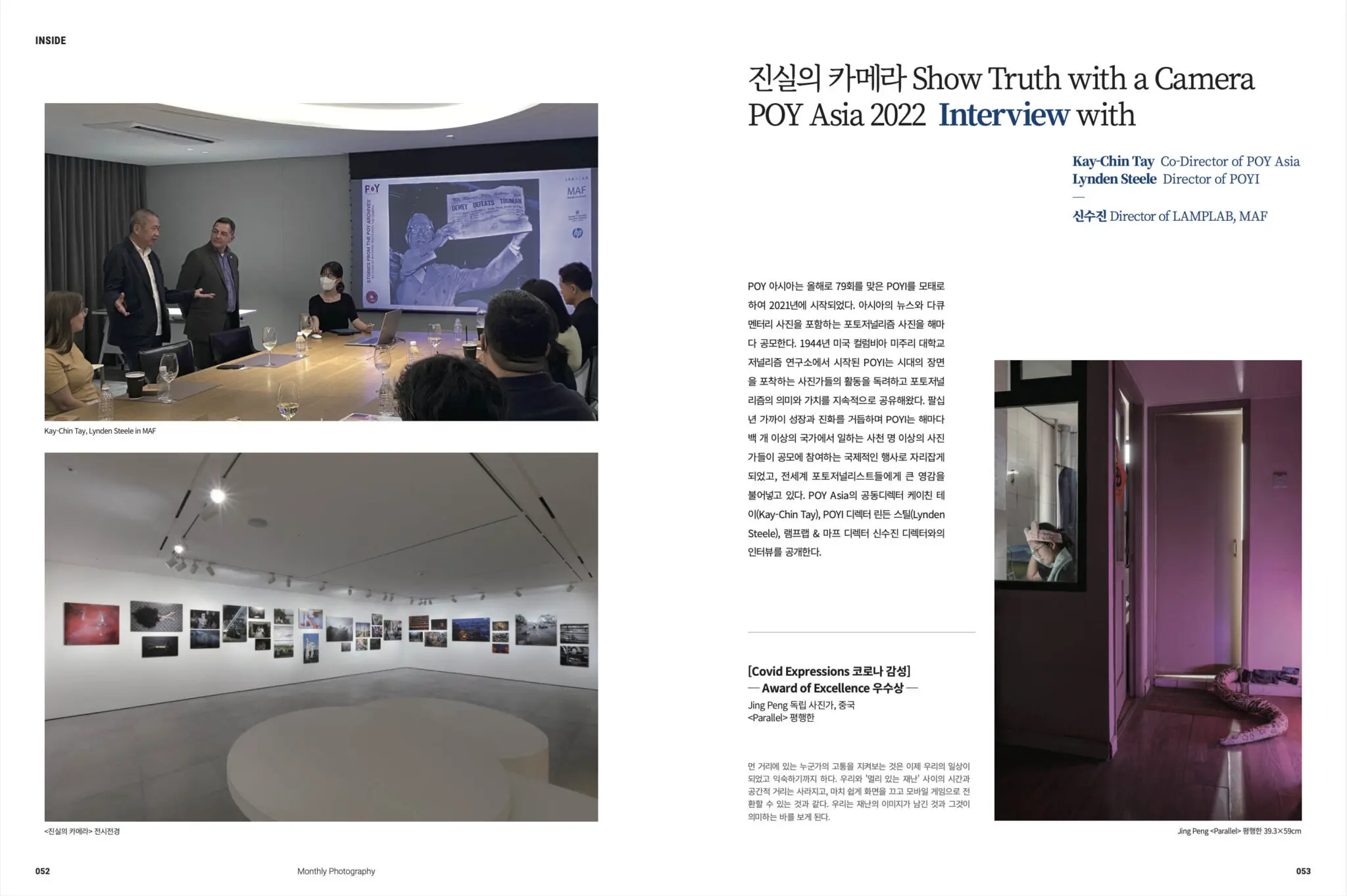
Suejin Shin: POY Asia began in 2021 based on POYI. We’d like to hear the purpose of POY Asia. And also, please tell us about a brief story of the founding process.
Kay-Chin Tay: As an Asian who was educated in the West, I have a special interest on how photojournalism practice in Asia is perceived and received in other parts of the world. What became more and more obvious to me is the fact that there is an imbalance of information. Often, Asian photographers can be doing great work and yet they will be unknown to folks outside of Asia. It is rather annoying to me that while I know a lot about Western photographers, I know relatively little about imagemakers in my own backyard. I personally believe that this gulf can be and needs to be closed. As a student in Missouri, I volunteered at POYI and have witnessed firsthand how success at POYI can lead to bigger things and I hope this platform can be replicated. Hopefully, POY Asia can help to address the imbalance.
How POY Asia was created is a very short story. When I was in Columbia to judge POYI in February 2020, Lynden broached the idea and I said yes without even thinking. What followed was a flurry of activities behind the scene. I think we were very lucky that POYI has a long history and tradition so a lot of the foundation was already laid long ago. All we had to do was to repurpose them for our new adventure. The toughest thing was getting more people to join us but once we found the right people, everything just went very fast.
Lynden Steele: Like Kay-Chin, I first encountered POY as a student. It was such a powerful experience. I still remember very clearly the first time I sat down in Tucker Forum to watch. I was captivated and skipped my classes… I couldn’t imagine a better teacher than seeing experts debate the journalistic qualities of the images and stories. I had never seen anything like it. While I did go back to my classes (and saved my grade), the experience stayed with me.
In 2019 I attended POY’s sister program, POY Latin America (POY Latam) in Quito, Ecuador. POY Latam is only for photographers who live and work in Spanish-speaking countries. It featured categories specifically designed to reflect the issues, culture and people who live in Latin America. Watching the judges discuss the work had the similar, profound effect on me as when I first watched POY. I saw stories that shared stories from Latin America that do not reach POY. It simultaneously revealed POY’s limitations and a path forward.
POY Asia follows the inspiration of POY Latam. Realizing the POY’s limitations of a broad program, POY Asia can share important stories from an Asian perspective.
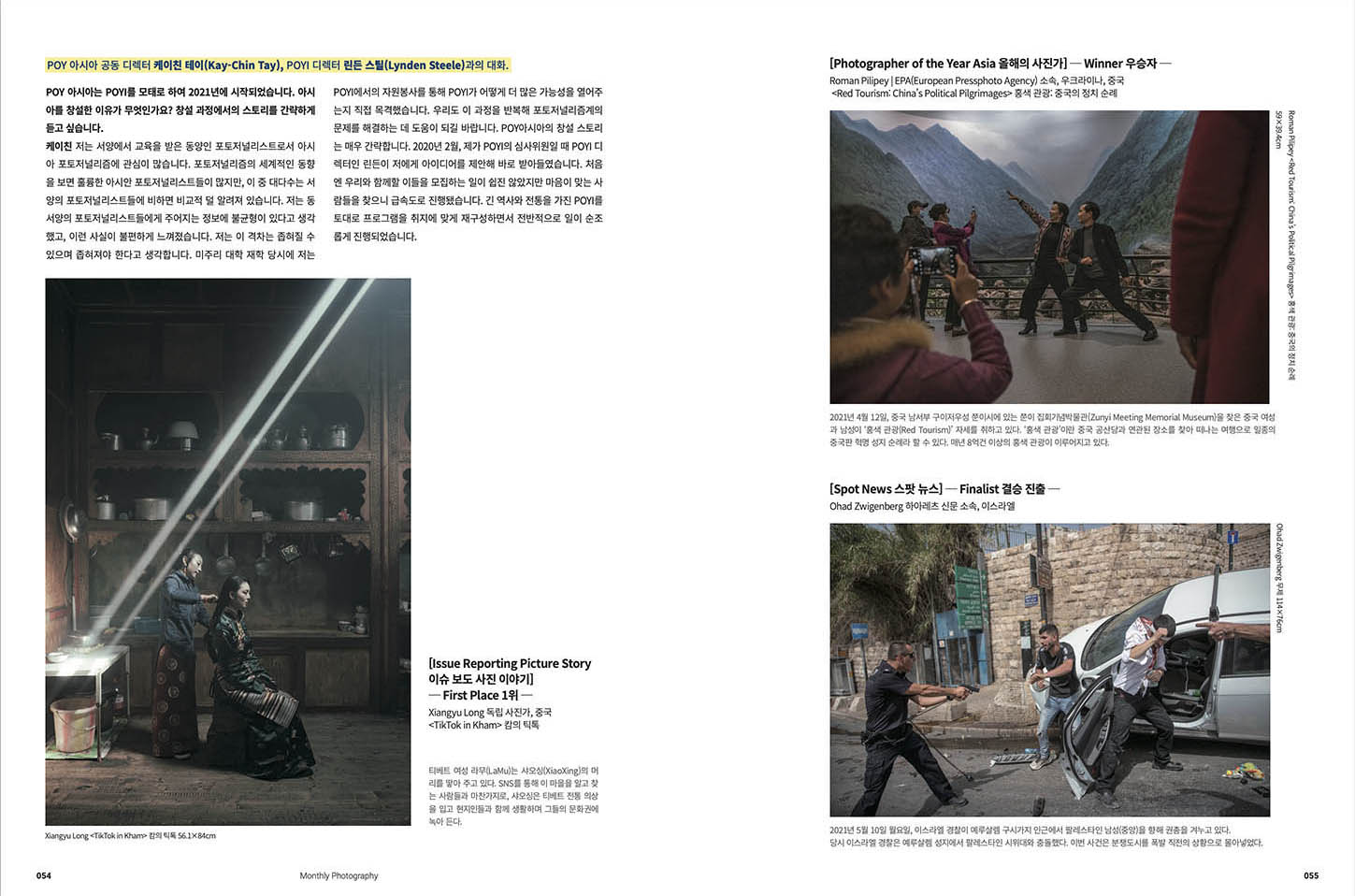
Suejin: Show Truth with a Camera was the inaugural exhibition of POY Asia. How did it happen at MAF in Seoul, Korea?
Kay-Chin: I remember very clearly that at the end of judging our inaugural competition in 2021, Dr Suejin Shin, MAF Director and a judge that year, said that she believes in the POY Asia mission and wants to find ways to help us. As I have known and worked with Suejin for more than 10 years, I know she means business. At the end of POY Asia 2022 competition, Suejin got in touch to congratulate us and also to offer her space for the exhibition. We had less than two months to put everything together but thanks to the very efficient team at MAF, everything just went smoothly. We are also thankful that our sponsor HP needed little persuasion to come on board to make the beautiful prints for the exhibition.
Lynden: With the creation of POY Asia, we realized that we now have a family of POY programs. The families we choose are based on relationships and trust. The exhibition in Seoul is due to Kay-Chin’s trusted relationships.
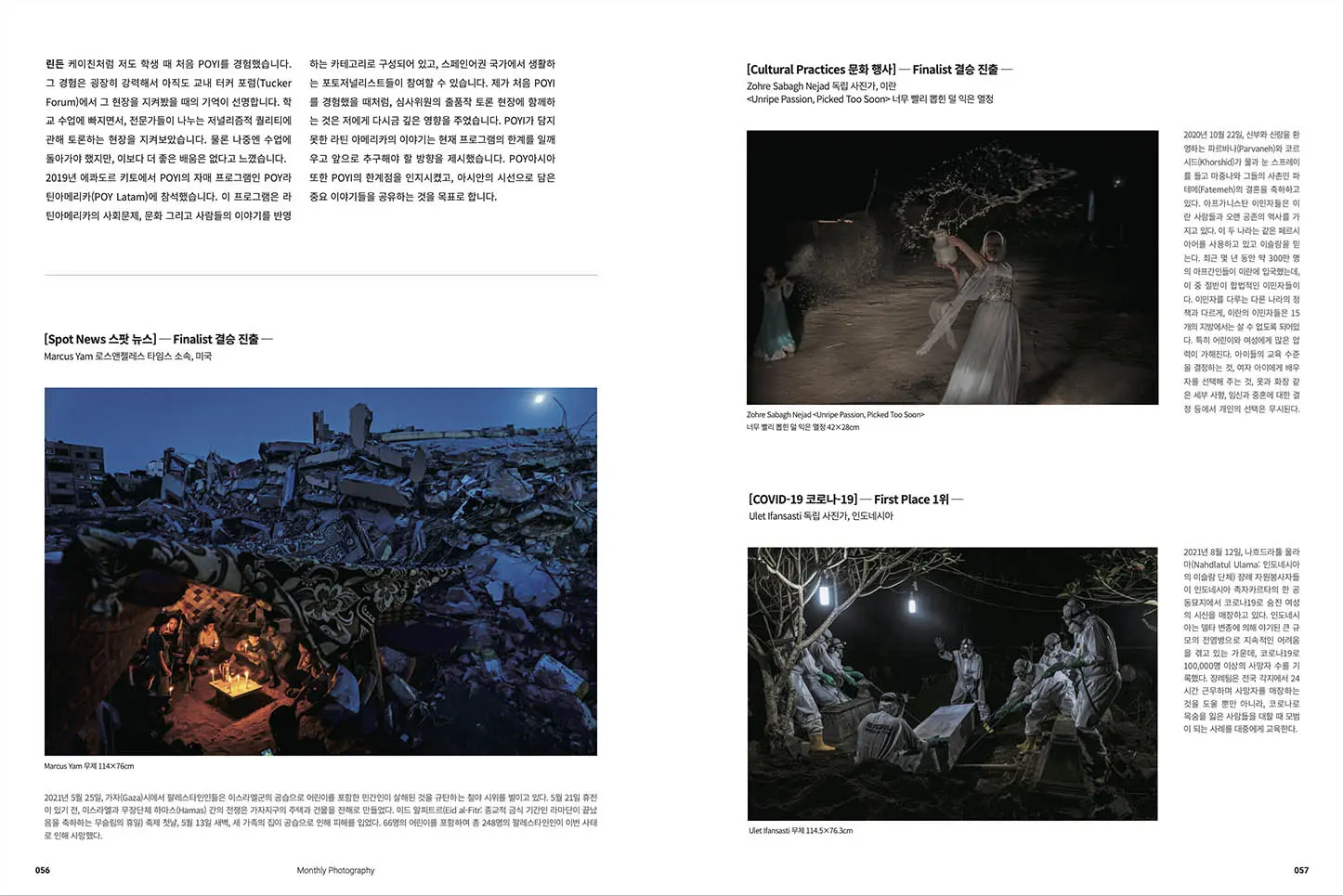
Suejin: You have chosen and presented 50 works out of many other photographs from 2022 POY Asia. What was the selection criteria? And what kind of photographs were presented at MAF?
Kay-Chin: If we wanted to do a full POY Asia show of all the award-winning entries, we would require five times the space we had at MAF. So it was really tough to select just 50 to represent this year’s competition. Top on our agenda was that the show must be representative of what went on in Asia in 2021. While we have a substantial section on COVID-19, it was important that other major events in Asia were showcased. In the show, we had stories from the withdrawal of US troops from Afghanistan; the protest in Hong Kong; the transition in China; and many other stories that may not be in the news but were no doubt important. One thing we were mindful about was that POY is not just about breaking news. A lot of our categories are for ‘quiet’ things that happen every day. It was a good reminder that photojournalists don’t sit around waiting for riots or disasters. The good ones find meaningful and obscure stories to share.
Lynden: Kay-Chin makes a good point about the “big stories.” We curated the show as an introduction to POY Asia, and wanted to make sure the biggest news stories of the year were represented. After all, these are the stories that dominate public media. However, we also took care to include the images that are quiet, or unexpected. It’s often that these kinds of stories are forgotten, which is a shame. The big news stories will always be remembered. They are documents of record. The smaller stories preserve the memory of what it felt like to live through these “big stories.”
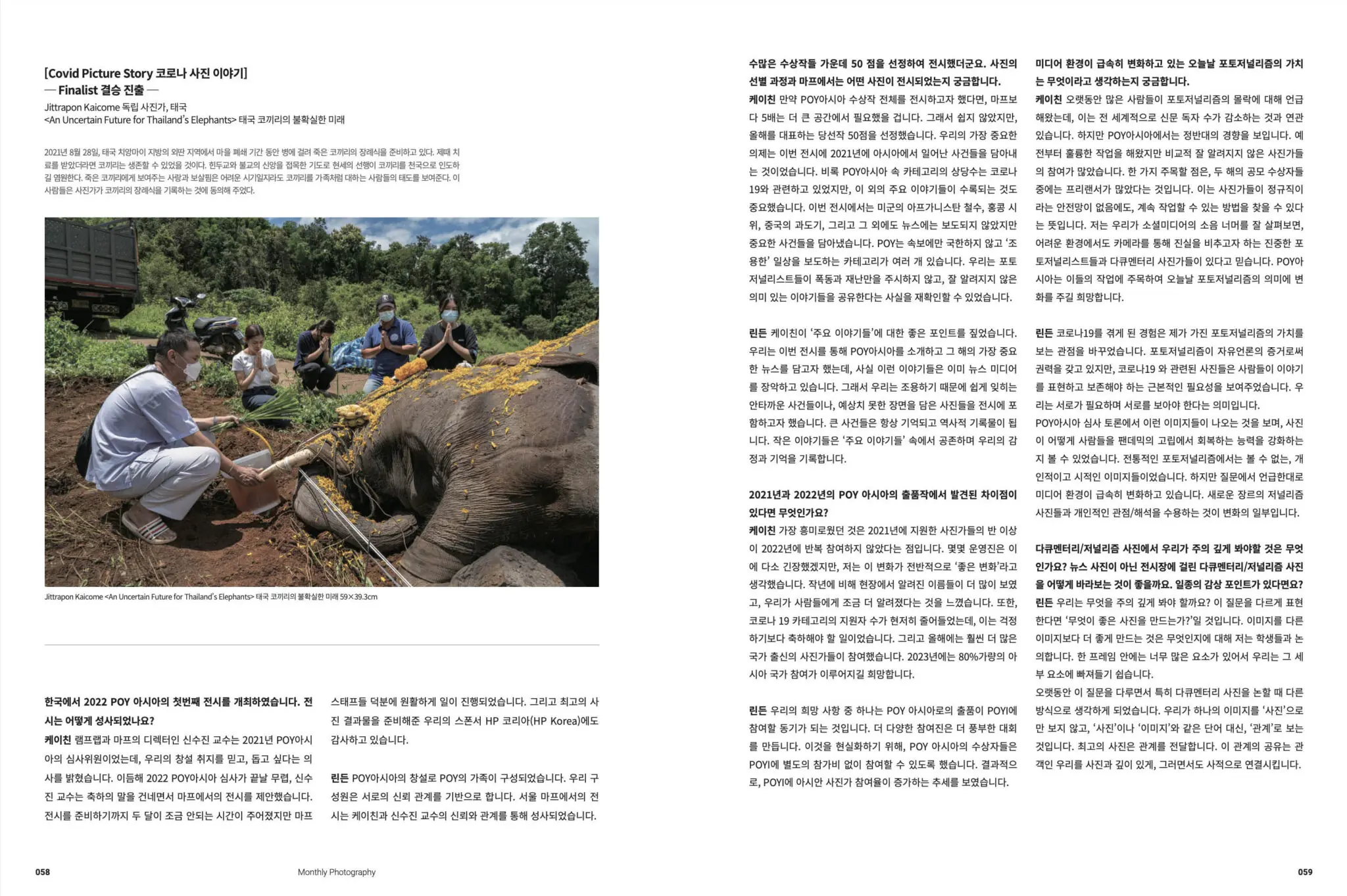
Suejin: What are the differences found in POY Asia entries for 2021 and 2022?
Kay-Chin: The most interesting thing for me was that more than half of photographers who entered in 2021 did not enter in 2022. Some organizers may be alarmed by that but when I looked at the overall quality of submissions, I knew the ‘correction of course’ was a good one. In comparison, the 2022 competition had a lot more known names in the industry which means more people are getting to know us. There was a very significant drop in the number of entries in the COVID-related categories but it was something to celebrate rather than to worry. Lastly, a lot more countries were represented in 2022. Hopefully, in 2023, we can reach 80% of Asia.
Lynden: One of our hopes is that entering POY Asia will encourage people to enter POY, and in the process, making it a more diverse and rich competition. To support this initiative, we made it free for winners in POY Asia to enter POY. Consequently, we did see an increase of entries from Asian photographers in POY.
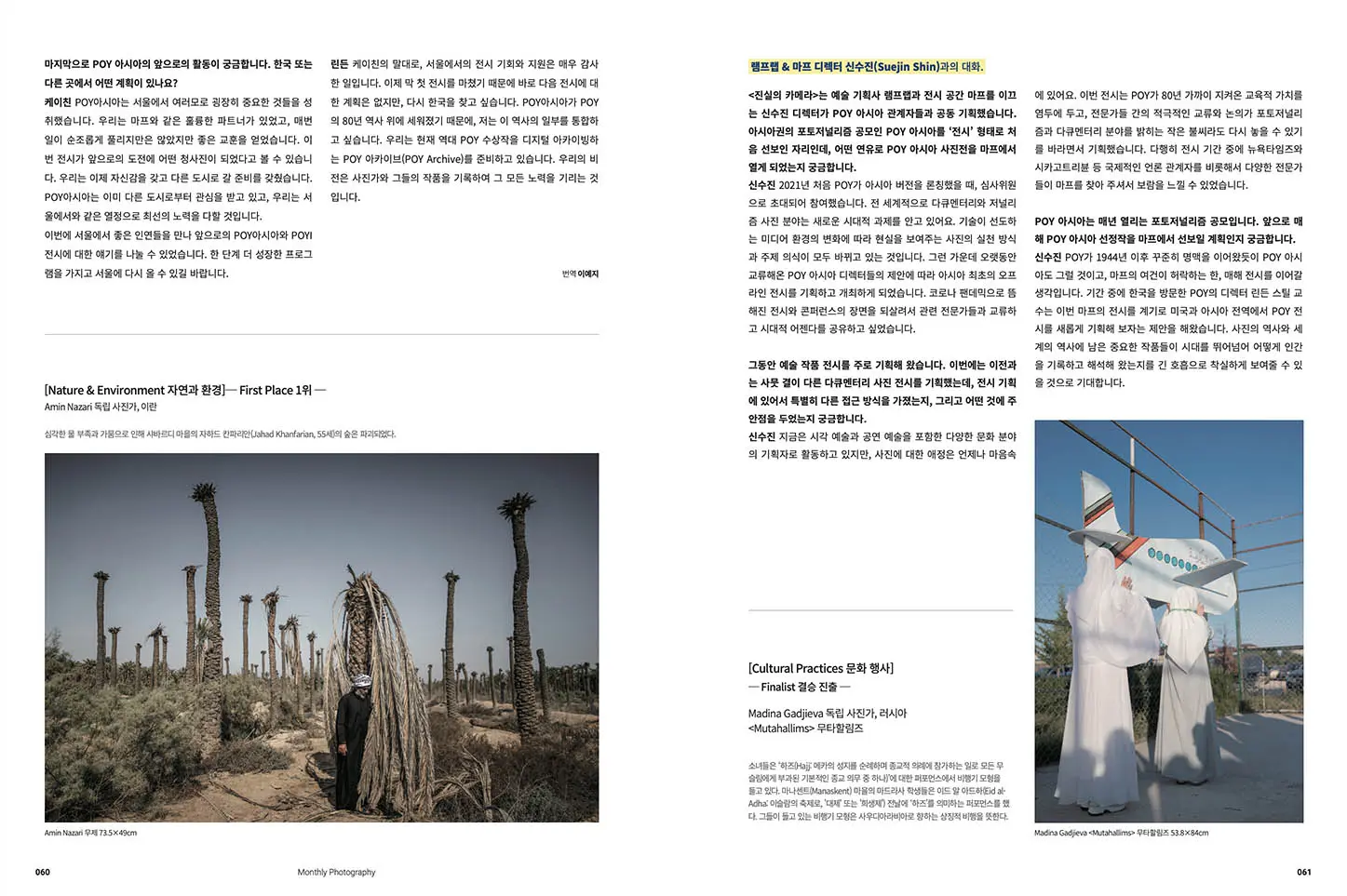
Suejin: What do you think of the value and attraction of photojournalism today when the media environment is rapidly changing?
Kay-Chin: For years, many people have been trying to write the obituary of photojournalism. It has a lot to do with the declining newspaper readership globally. But what we see in POY Asia is quite the opposite. There are a lot of new names unfamiliar to us in the past and they are producing excellent work. One thing worth noting is that there were more winners in both our competitions who identified themselves as ‘independent’. It means that photographers have been able to find ways to continue working despite not having the safety net of full-time employment. I believe if we look beyond the noise made by social media platforms, we can see that serious photojournalists and documentary photographers who are devoted to showing truth with the camera will continue to do so despite the difficult media environment. Hopefully, POY Asia can help to make a difference too by highlighting their good work.
Lynden: The experience of Covid has changed my perspective as to the value of photojournalism. While it continues to hold power as evidence of a free press, photography during Covid showed us the fundamental need to express and preserve our stories. We need each other and we need to see each other.
As I saw these images emerge from judges’ discussions in POY Asia, I saw how these images strengthened the resilience to cope with the pandemic isolation. It was personal and poetic, neither of which align with traditional journalism. However, as the question states, the media environment is rapidly changing. The embracing of these images and these personal perspectives is part of this change.
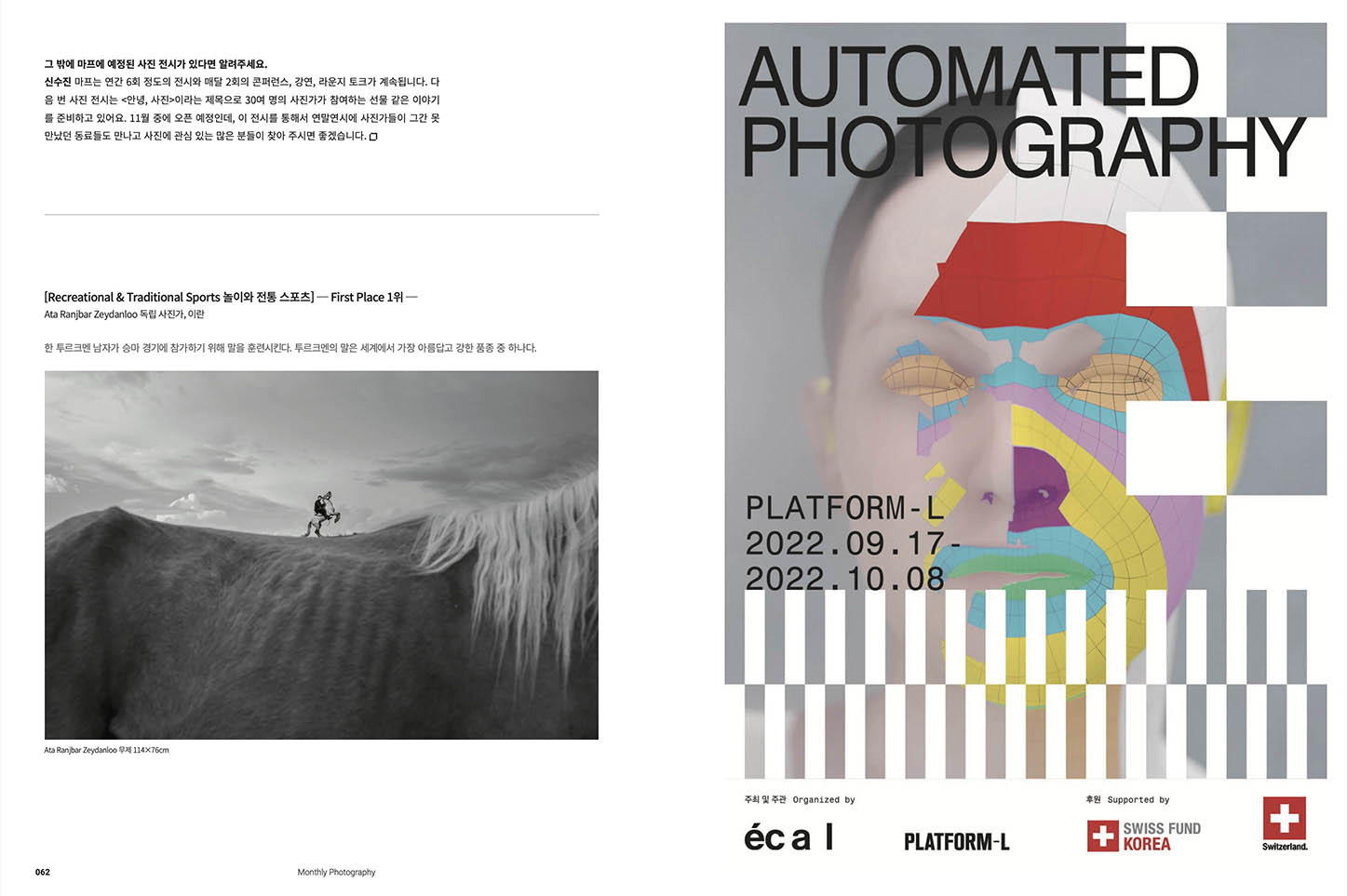
Suejin: What should we look at carefully in documentary and journalistic photographs shown at exhibitions?
Lynden: What should we look at carefully? Another way to ask this question is: What makes a good photograph? I discuss this with my students. What makes an image better than another one? There are so many elements within a frame, it’s easy to get lost in the details.
Over time, I came to another way to think about this question, especially when discussing documentary work. When looking at images, stop thinking of pictures as pictures. Instead of using a word like “photograph,” “image” or “picture,” use the word “relationship.”
The best images convey a strong relationship. It is this sharing of a relationship that allows us, as viewers, to connect deeply and personally with an image.
Suejin: Lastly, what is upcoming activity of POY Asia? Please tell us if there’s any plans in Korea or any other countries.
Kay-Chin: What POY Asia managed to achieve in Seoul is very important in many ways. We were fortunate to have great partners like MAF which made things easier. While things were not always smooth sailing, we learned good lessons. It would be an understatement to say that after Seoul, we now have a good blueprint to tackle the challenges in the future. But yes, we are now much more ready to go to other cities with confidence. We already have expressions of interest from other cities and will try to pursue every lead with the same enthusiasm.
In Seoul, we met lots of good people and have initiated discussion of more POY Asia and POYI exhibitions for the coming years. We are hopeful about coming back again with even better programs.
Lynden: As Kay-Chin has said, we are very grateful for the opportunity and support to exhibit in Seoul. As we are just completing our inaugural exhibit, we don’t yet have plans for another one, but we would like to return to Korea. As POY Asia is built on 80 years of POY, I hope to incorporate some of this history. We are currently working on a digital POY Archive that would save all the winning entries of all the POY competitions. Our vision is to preserve the photographers and their work so that efforts will always be honored.

